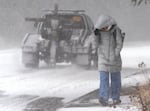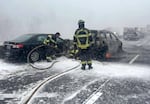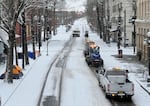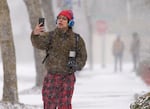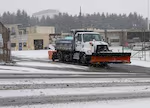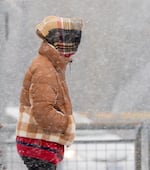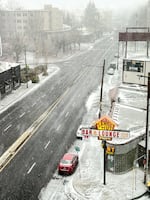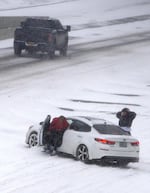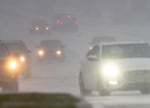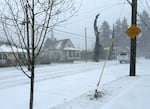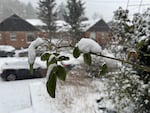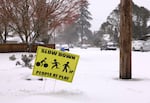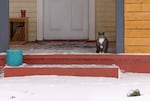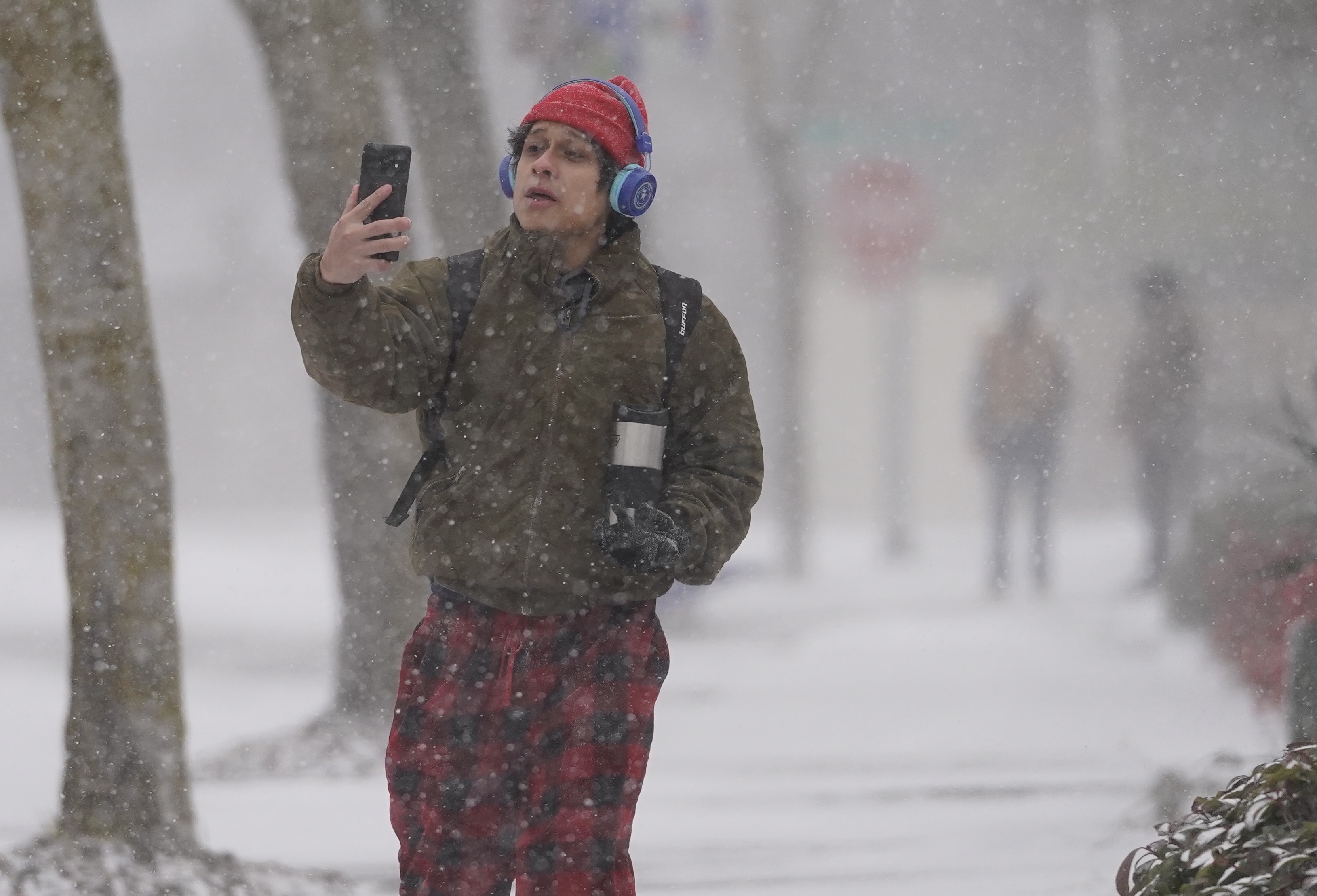
A man videos the snowfall as he walks to work in Beaverton, Ore., Feb. 13, 2025. A Guatemala native, he says he has lived in the Portland area for eight months and this is his first time seeing snow.
Kristyna Wentz-Graff / OPB
Portland’s sunny days are done and snow started to fall around the region Thursday. The National Weather Service has issued a winter storm warning for the Portland area, with current predictions saying the metro area should expect up to 2 inches of snow and sleet.
Dylan Rivera is the public information officer with PBOT. He joins us to share how the agency is preparing streets. We’ll also hear from Jes Larson, the assistant director of homeless services for Washington County, to hear how workers there are helping people on the street stay warm and safe.
Note: The following transcript was transcribed digitally and validated for accuracy, readability and formatting by an OPB volunteer.
Dave Miller: This is Think Out Loud on OPB. I’m Dave Miller. We start today with the weather. Today is one of those days when kids in the Portland area can rejoice because the snow forecast seems to have been accurate. It called for a handful of inches, and those inches seem to be arriving. More could be on the way. In a few, minutes we’ll hear what the cold and snow mean for homeless services in Washington County. We start with the situation on the roads. Dylan Rivera is a public information officer for the Portland Bureau of Transportation. He joins us now. Welcome back to the show.
Dylan Rivera: Thank you.
Miller: What have you heard or seen on Portland roads this morning?
Rivera: Well, we’ve got at least an inch in most of the city, an inch and a half or more in the southwest hills and some blowing wind, blowing it around east of I-205.
Miller: What does the latest forecast look like from the perspective of roads and safety? I mean, what are you looking for in the next, say, 24 hours?
Rivera: We’ve been told to expect freezing rain to come as early as 1p.m. ‒ so in less than an hour ‒ to the Portland area, and that could bring a tenth to a quarter inch of ice on top of the snow that’s already out there today. And subsequent to that, later tonight or early tomorrow morning, there’s potential for another layer of snow on top of that ice. So, a multi-layer cake.
Miller: Yeah, not the tastiest kind, though. I mean, snow can be tricky, but ice is worse in just about every way, as anybody who remembers last year really remembers. What can you do at this point to prepare for freezing rain and ice?
Rivera: We prepare ourselves and we try to prepare the public. We prepare ourselves by really leaning on road salt, in addition to the liquid anti-icer in advance of freezing rain. We prepare the public by reminding folks that ice is really different than snow. It’s treacherous. It can make sidewalks dangerous. It can make the front steps of your porch dangerous. Last year, in the January 2024 ice events, we had hundreds of emergency department visits from people slipping and falling, and so don’t become one of those numbers. When it comes to freezing rain, it is really treacherous, and everyone needs to do their best to stay indoors.
Miller: How has the bureau’s response to snow and ice evolved in recent years?
Rivera: Well, the big change came in 2017. Prior to that, we had a somewhat unique response for a city our size in that we were not using road salt. We were using the liquid deicer, that’s pretty ubiquitous, but in 2017, we started using road salt and now our response since 2017 has been just basically learning and adjusting, and so we’ve learned a lot. Road salt has been highly effective, and it has really helped clear our routes and deliver on our promise of one passable lane on our routes, each, one passable lane in each direction on our routes as soon as possible after a snow or ice event.
Miller: But when you say our routes, my understanding is that doesn’t mean all the roads in Portland, it just means the bigger ones. I mean, I’ve seen a number of residential streets in Portland that are just beautifully white and snowy, but with no plowing anywhere in sight.
Rivera: Absolutely, yeah. So our response on snow and ice and our priorities are pretty typical for a city our size with the weather we get. Very similar to Seattle, Eugene, Oklahoma City, Saint Louis. We focus on the routes that public transit service needs, that the buses need, streetcar needs, police, fire, and ambulance, first responders need, so routes to hospitals, the major arterials that are served by buses. That way, first responders can attend to life safety emergencies safely. They can reach you in the event of a life safety emergency. And the public, as conditions improve… As you know, the ice starts to thaw as we’re dealing with slush or snow. You can go out there, you can safely walk to public transit, and because of our work, those public transit lines will recover first and that’s your first option if you do need to travel.
Miller: You recently let the public vote on naming five snowplows in the city’s fleet, and the public did not disappoint. The winners are The Big Leplowski, Beverly Clear-y, Brrrrnside, Salt & Thaw, and Plowy McPlowface. Are these snowplows on the roads now?
Rivera: They sure are. Five of our 56 snowplows, and you can track them. The names are starting to emerge on the Winter Weather Center, our interactive snowplow map where you can see all our routes citywide, and you can see our vehicles moving on those routes in real time.
Miller: All right, something to do if people are stuck at home right now. Dylan, thanks very much.
Rivera: Thank you.
Miller: Dylan Rivera is a public information officer for the Portland Bureau of Transportation.
I’m joined now by Jes Larson. She is the assistant director of homeless services for Washington County. Jes Larson, welcome to the show.
Jes Larson: Thanks, Dave. Good to be here.
Miller: What triggers you to open emergency shelters, emergency warming shelters, in Washington County?
Larson: We have an established set of criteria that we use to track the weather as any storm begins to set in. It has a combination of factors and metrics, including the overnight or low temperatures and any accumulation of snow or ice conditions that help us determine when we need to activate, and then also help us understand when it’s safe to deactivate the shelters once the storm has passed.
Miller: I assume that the weather now means you have activated these shelters?
Larson: Absolutely. In fact, the storm has set in for those of us who have homes, but it’s actually been very cold all week long, and so we activated our severe weather shelters earlier this week in Washington County, because the overnight temperatures were so low it was unsafe for folks outside.
Miller: How many of these emergency shelters are open right now?
Larson: Great. So we have, on any day of the year when we’re not in an emergency weather situation, over 400 shelter beds operating throughout the county. And in these severe weather events, we pop up additional shelter capacity that ensures no turnaways. So we will grow that capacity as much as we need to keep folks coming in the doors. We have two sites that have been open all week long and last night, or I believe it was this morning. I hear we’ve opened a third site because we did reach capacity at those first two sites, and now we are operating a third. And we will continue to make sure we have enough capacity through the storm to ensure no one gets turned away.
Miller: How do you spread the word about these shelters? I mean, I’m thinking in particular if people are in encampments or sleeping under a bridge or in a car, all around a pretty large county. How do you let them know that there are warm indoor spaces that have just been opened where they can go?
Larson: Thanks, Dave. This is the importance of a coordinated outreach system. So we have outreach teams that work in teams of two, and they’re geographically assigned throughout the county, always working with our unsheltered populations. And then during an event like this ‒ so a severe weather storm ‒ they focus their attentions away from sort of housing planning and engagement and addressing that relationship building, so we can get folks back inside in permanent housing options, and they go into emergency active or emergency action mode, making sure people have the gear they need, but more importantly know that the shelters are open and they can come inside, bring their pets, bring their belongings. It’s more important to be safe inside than to stay outside during these events.
Miller: That’s an important point, because we’ve often heard of one of the barriers, a reason that some people may not seek shelters, is because of their belongings or because of their pets. So, nobody is turned away?
Larson: That’s exactly right. That is the point. We are in an emergency mode, and we want to make sure that everyone has a safe place to be during this weather event. So we had, I believe, 10 pets between our three sites last night in addition to the 100 guests, individuals and families who are supported in our emergency weather shelter capacity.
Miller: What kind of partnerships do you have with cities in Washington County or nonprofits?
Larson: The partnerships are key to our coordination efforts. We simply can’t do this work alone in Washington County, and we don’t do the work alone in Washington County. So we activate daily coordination calls with all of our partners. That includes our city liaisons. We have staff colleagues in the city jurisdictions who are helping support the needs of their local cities in coordination with our county coordinated system in Washington County. So those colleagues are on the call. They’re coordinating with their libraries, they’re coordinating with their law enforcement, their city outreach staff who are part of our system.
And then of course those case management service provider organizations, outreach providers, and shelter providers are all key parts of our system as well. And I just really want to give a shout out to a few. Our sheriff’s department has been an important partner, offering space in one of the sites in Hillsboro to support this pop-up shelter capacity. The city of Beaverton is lending us their community center for the event, and the Salvation Army is also hosting us, now that we’ve run out of capacity in those other two places.
Miller: What can you tell us about the Tigard Access Center?
Larson: Ah, well, this is really exciting news. So as we’ve been building our system of care to address homelessness in Washington County, we’ve been bringing on purpose-built infrastructure, if you will, to support these homeless services. We didn’t used to have permanent shelter programs and soon we’re going to have permanent access centers too, and these are going to be day shelters, if you will, where folks can come in who are unsheltered, maybe waiting still to get a shelter bed. But they’re working with the case manager, getting their daily needs met, have a place to store their belongings. And when we have these access centers come online fully in Washington County, they will have a dual purpose of being our pop-up additional shelter capacity when we have storms. So we have 400 beds every night of the year, but soon we will also have four access centers that can open up for these inclement weather events, and Tigard’s will be our first access center coming online this spring.
Miller: What’s it like ‒ let’s say the temperature goes up to 37 at some point in the coming days and the precipitation stops ‒ what’s it like to shut down emergency warming shelters when it’s still quite cold outside, but above the county’s threshold?
Larson: Yeah, it’s always challenging. I’ll be frank with you, Dave, because the folks who come to our shelters often are waiting for those shelter beds. So while they’re staying in the severe weather shelters during the weather event, the case managers there are helping them find out where they’re on the list, see if there’s a bed that opens up, help them work towards that next step so they can stay inside ultimately. And our outreach providers provide transportation to other spaces in the community where folks can stay and get warm throughout the day when we deactivate. And we’re always very mindful to make sure that even if the temperatures are warming, what are the conditions on the sidewalks, because these folks who are unsheltered, they need to take the sidewalks to get to the bus and we want to make sure it’s safe for them to travel.
Miller: Jes Larson, thanks very much.
Larson: Thank you, Dave.
Miller: Jes Larson…
Larson: Stay safe.
Miller: You too. Jes Larson is the assistant director of homeless services for Washington County.
Contact “Think Out Loud®”
If you’d like to comment on any of the topics in this show or suggest a topic of your own, please get in touch with us on Facebook, send an email to thinkoutloud@opb.org, or you can leave a voicemail for us at 503-293-1983. The call-in phone number during the noon hour is 888-665-5865.
